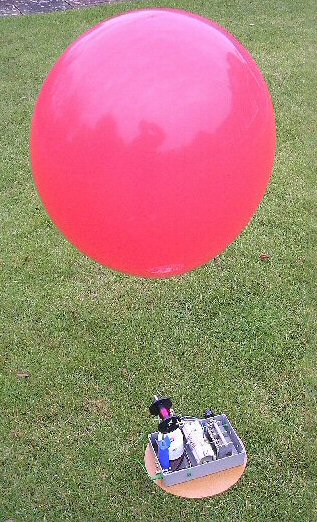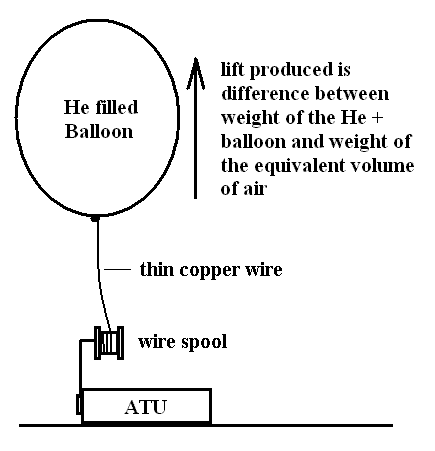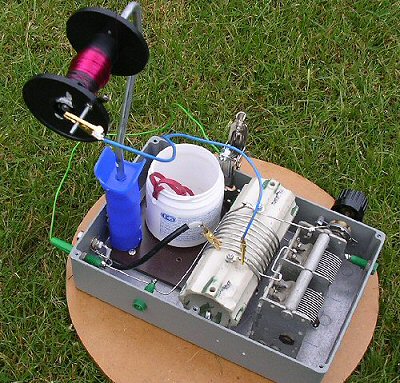vertical antenna for the 80m band using a Helium (He) balloon
NOTE: I am still working on this page, so sorry about the spelling, english and the science !
Balloons were filled with He gas and used to support 20 to 40m of thin copper wire which forms a vertical antenna for the 80m band.
Also described is the ATU used to match this to the receiver (or low power Tx).


The Idea - He balloon provides lift to carry wire antenna into the air
I built my first communication receiver in 1982 when I was about 15. It was a 6 transistor direct conversion receiver for the 80m band cobbled together from lots of circuits to my own design. The radio, antenna, feed where all home-made and I listened on an old pair of HG Brown high impedence headphones. From about 1982 to 1985 I heard over 106 countries using little radio and learnt about the countries of the world as I had never done at school - it was a terrific time and I loved the long winter months and cold mornings because of it!
Some thoughts about the 80m band
When I left home 80m became my christmas radio activity - something I did as a sort of ritual when I came back home to my mum and dad (they have a relatively 'radio quite' location out of the city) for the holiday period. I tried all sorts of pre-amps, tuners and antennas; dipoles, loops, inverted V's etc. I had always dremnt of trying out a large vertical but could not really see how the neighbours and my parents would let me get away with it, even if I could make such a thing. Then one day I noticed that Maplin Electronics were selling He gas cylinders ment for filling party balloons and I realised I might be able to do the vertical after all!
Helium gives lift
Imagine a cube container, each side of which is 1m in length - the amount of air contained within that volume will have a mass of about 1.16 Kg but the same volume of Helium would only be 0.16 Kg ! so air is over 7 times the density of Helium. Hydrogen is even less dense (half the density of He) but there is the risk of explosion so Helium is a safer option.
|
GAS (at 300K)
|
Density (kg/m³)
|
|
Air*
|
1.16
|
|
Methane
|
0.667
|
|
Helium (He)
|
0.164
|
|
Hydrogen (H2)
|
0.082
|
(Note: Air is 78% Nitrogen, 21% Oxygen and 1% Argon and other trace gases)
As Helium is roughly a 1/7th the density of air a balloon filled with He will be much lighter than the same balloon filled with air. Like a bubble rising in a drink, the He balloon will rise in the air. The lift is produced by the difference in density between the air and He gas (but you need to take into account the weight of the rubber balloon in the calculation).
ONE LARGE OR MANY SMALL BALLOONS?
I managed to get hold of some giant party ballons on the internet which are about 10 times the size of standard balloons. These are great as 1 of these will have less surface area than the equivalent volume of say 10 smaller balloons and so will weigh less in terms of rubber to lift. This leaves more lift for the antenna wire. I found that one giant balloon easy lifted 20m of 35 SWG wire.
THE ANTENNA
The antenna could not be simpler - 1/4 or 1/2 wavelength of thin copper wire (I used 35 SWG enamalled copper wire). This amounts to 20 or 40m of wire. It is carefully coiled up on the wire spool with one end soldered to a tag. When the balloon is let free it pulls the wire from the spool and it goes up at a nice slow pace. Once up, a croc-clip goes from the ATU coil to the solder tag - the antenna is connected !
In these tests I used a 1/4 wavelength (20m) vertical but there was still plenty of pulling power on the balloon I used and I think if I used non enamalled wire I could have got a 1/2 wavelength (40m) vertical to work. This will present a much higher impedence to the circuitry but the ATU should handle that all ok.
There is a movie clip link at the end of the page if you want to see the balloon going up! (it's 7MB though)
ATU
Shown below is a picture and diagram of the ATU used to match the vertical to the receiver. It simply consists of a tuning capacitor and large coil resonant for 80m. Taps are made a few turns from the Earth end of the coil for the low impedence reciever output and the antenna is tapped in near to the other end. The large croc-clip went to the earth - a 2m metal bar driven into the soil. As this ATU is used for transmitting as well as for these reciving experiments I used a 'heafty' coil and high V capacitor but much smaller and simpler system could be made using the cheap japanese tunning caps used in crystal sets etc. The capacitor is simply tuned for best S/N ratio.
Note: the white pot is not used in these experiments and is used as an insulating cup to hold the bottom of a mast. In these experiments I used a 20m mast as a vertical antenna.
RESULTS
It was very exciting to see the balloon going up and taking my vertical antenna with it - but after all the excitment how did it do?
Well the first thing is that there has to be very little wind for the antenna to go up verticaly. Even a slight breeze will take the balloon away and you have a slopper rather than a vertical. However in my location there are few obsticles and no high buildings around so there is still a lot of wire in the sky and the ATU will tune this perfectly well.
I first tried it out in twilight, so that I could see what i was doing, and continued to listen on 80m as the light faded. Europian signals were really rather strong, but verticals pick up a lot of noise. I then got up early in the mornings to listen on the 80m DX. It was teriffic! there were many state-side stations at good signal strengths, perhaps better than I had ever heard on such a simple reciever, but the noise level was very high as well!
lots of amazingly strong (59++) Europeans including .....
SM7EHU, SM7YES, LZ1JY, G4KHM, DL8FL, OE6MBG, IK4IEE ...
and my best long distance from the UK (DX) .....
W9DD (42), W9AD (57!), W1IA, K2MUB, K7RL, VE6JY, WQ7X, W6RJ
NOTE: you really need as good an earth connection as possible for this antenna. I used a steel pipe driven 5' into the gound but wire radials (say 20m or so long, as many as possible) would also be required if you wanted to use the antenna to transmit effectively. As the wire is so thin only low power ca. 10W perhaps might be used (it also depends on the seperation of the plates on the tunning capacitor etc.)


Above: picture and diagram of the ATU used to match the vertical to the receiver
movie of balloon antenna going up (Note: 7Mb)
Some thoughts about the 80m band
back to G1EXG's Radio page
Dr Jonathan Hare, E-mail: jphcreativescience@gmail.com
NOTE: Although none of the experiments shown in this site represent a great hazard, neither the Creative Science Centre,
Jonathan Hare nor The University of Sussex can take responsiblity for your own experiments based on these web pages.
THE CREATIVE SCIENCE CENTRE
home | diary | whats on | CSC summary | latest news





